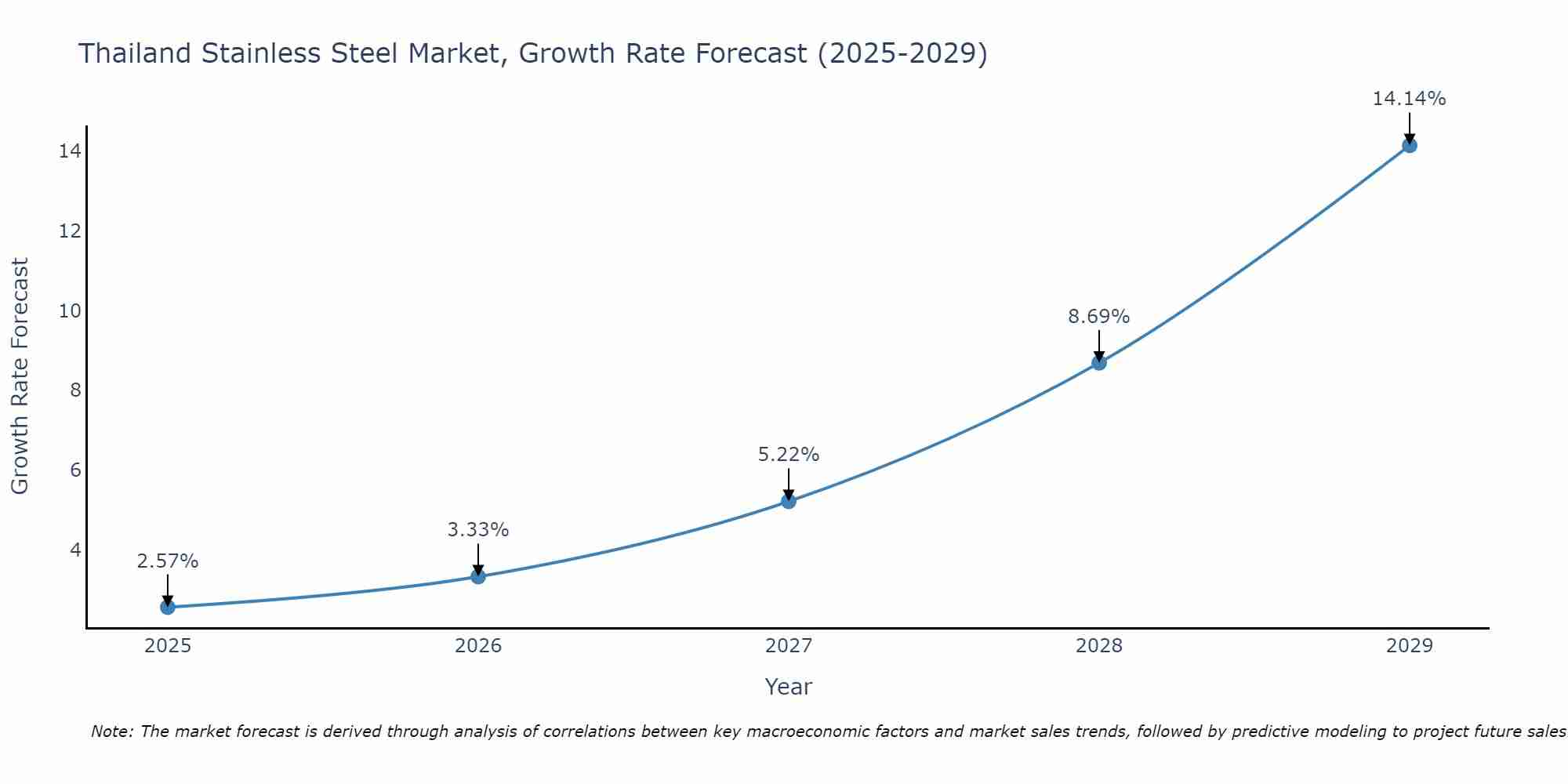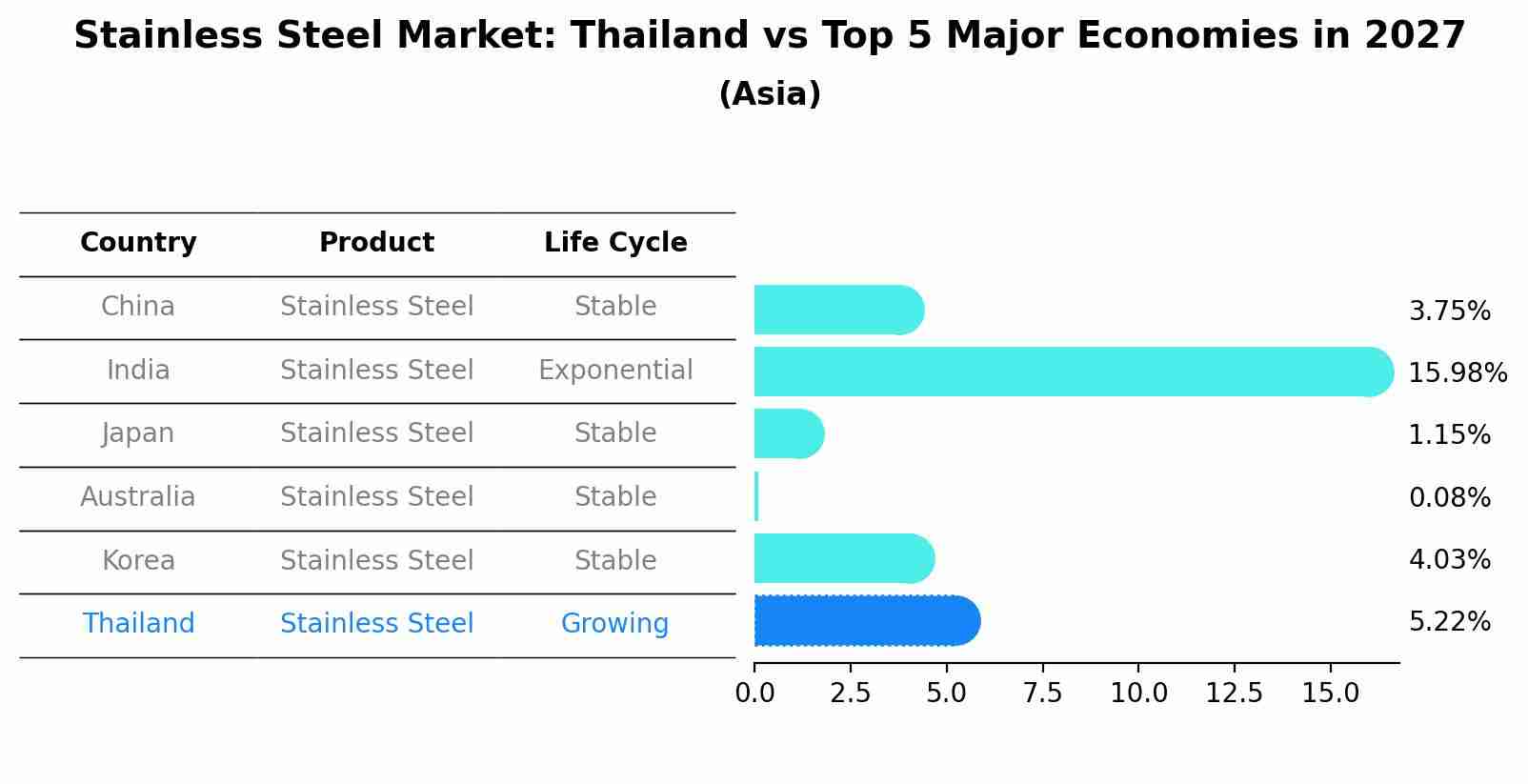Thailand Stainless Steel Market (2025-2031) Outlook | Value, Revenue, Companies, Forecast, Share, Growth, Size, Trends, Industry & Analysis
| Product Code: ETC356785 | Publication Date: Aug 2022 | Updated Date: Aug 2025 | Product Type: Market Research Report | |
| Publisher: 6Wresearch | No. of Pages: 75 | No. of Figures: 35 | No. of Tables: 20 | |
Thailand Stainless Steel Market Size Growth Rate
The Thailand Stainless Steel Market is poised for steady growth rate improvements from 2025 to 2029. Commencing at 2.57% in 2025, growth builds up to 14.14% by 2029.

Stainless Steel Market: Thailand vs Top 5 Major Economies in 2027 (Asia)
In the Asia region, the Stainless Steel market in Thailand is projected to expand at a growing growth rate of 5.22% by 2027. The largest economy is China, followed by India, Japan, Australia and South Korea.

Thailand Stainless Steel Market Synopsis
The Thailand stainless steel market is a robust and dynamic sector within the country`s broader steel industry. Stainless steel is widely utilized in various applications due to its corrosion resistance, durability, and aesthetic appeal. Key sectors driving demand include construction, automotive manufacturing, and the food and beverage industry. Thailand construction boom has resulted in a surge in stainless steel usage for architectural components, while the automotive sector requires stainless steel for exhaust systems, trim, and other components. The market also caters to the growing demand for kitchen appliances, utensils, and sanitary equipment. Importantly, as Thailand continues to promote sustainable building practices, the demand for stainless steel in green construction is expected to rise.
Drivers of the Market
The Thailand stainless steel market is on an upward trajectory driven by multiple factors. A significant factor is the expanding construction sector, where stainless steel finds extensive use in architectural elements, kitchen equipment, and sanitary fittings due to its corrosion resistance and aesthetic appeal. Moreover, the growing food and beverage industry in Thailand is boosting the demand for stainless steel equipment, such as tanks, pipelines, and food processing machinery, to ensure hygiene and product safety. Additionally, the medical and healthcare sector relies on stainless steel for equipment and instruments, further propelling market growth. The durability and recyclability of stainless steel make it an attractive choice across various industries, supporting its continued growth.
Challenges of the Market
The Thailand stainless steel market faces several challenges in its quest for growth and sustainability. Firstly, the market`s reliance on sectors such as construction, automotive, and manufacturing makes it susceptible to economic fluctuations and changes in consumer preferences. Secondly, ensuring the quality and purity of stainless steel products is critical for various applications, and any lapses in quality control can result in product rejection and reputational damage. Additionally, competition from imports and global stainless steel manufacturers can exert downward pressure on prices and market share. Lastly, environmental regulations related to stainless steel production can add to compliance costs.
COVID-19 Impact on the Market
The stainless steel market faced challenges during the pandemic due to reduced demand from the hospitality and foodservice sectors. Stainless steel is widely used in commercial kitchens and food processing equipment. As these sectors were severely affected, stainless steel manufacturers experienced decreased orders. However, the medical equipment and healthcare sectors saw increased demand for stainless steel products, partially offsetting the losses.
Key Players in the Market
The stainless steel market in Thailand is marked by the presence of companies like Thai-German Products Public Company Limited, specializing in stainless steel production and distribution for various industries.
Key Highlights of the Report:
- Thailand Stainless Steel Market Outlook
- Market Size of Thailand Stainless Steel Market, 2024
- Forecast of Thailand Stainless Steel Market, 2031
- Historical Data and Forecast of Thailand Stainless Steel Revenues & Volume for the Period 2021-2031
- Thailand Stainless Steel Market Trend Evolution
- Thailand Stainless Steel Market Drivers and Challenges
- Thailand Stainless Steel Price Trends
- Thailand Stainless Steel Porter's Five Forces
- Thailand Stainless Steel Industry Life Cycle
- Historical Data and Forecast of Thailand Stainless Steel Market Revenues & Volume By Product for the Period 2021-2031
- Historical Data and Forecast of Thailand Stainless Steel Market Revenues & Volume By Long for the Period 2021-2031
- Historical Data and Forecast of Thailand Stainless Steel Market Revenues & Volume By Flat for the Period 2021-2031
- Historical Data and Forecast of Thailand Stainless Steel Market Revenues & Volume By Application for the Period 2021-2031
- Historical Data and Forecast of Thailand Stainless Steel Market Revenues & Volume By Polish finishing for the Period 2021-2031
- Historical Data and Forecast of Thailand Stainless Steel Market Revenues & Volume By Exhaust system for the Period 2021-2031
- Historical Data and Forecast of Thailand Stainless Steel Market Revenues & Volume By Surgical instrument for the Period 2021-2031
- Historical Data and Forecast of Thailand Stainless Steel Market Revenues & Volume By Others for the Period 2021-2031
- Historical Data and Forecast of Thailand Stainless Steel Market Revenues & Volume By End User for the Period 2021-2031
- Historical Data and Forecast of Thailand Stainless Steel Market Revenues & Volume By Consumer goods for the Period 2021-2031
- Historical Data and Forecast of Thailand Stainless Steel Market Revenues & Volume By Automotive for the Period 2021-2031
- Historical Data and Forecast of Thailand Stainless Steel Market Revenues & Volume By Food & beverage for the Period 2021-2031
- Historical Data and Forecast of Thailand Stainless Steel Market Revenues & Volume By Oil & gas for the Period 2021-2031
- Historical Data and Forecast of Thailand Stainless Steel Market Revenues & Volume By Others for the Period 2021-2031
- Thailand Stainless Steel Import Export Trade Statistics
- Market Opportunity Assessment By Product
- Market Opportunity Assessment By Application
- Market Opportunity Assessment By End User
- Thailand Stainless Steel Top Companies Market Share
- Thailand Stainless Steel Competitive Benchmarking By Technical and Operational Parameters
- Thailand Stainless Steel Company Profiles
- Thailand Stainless Steel Key Strategic Recommendations
Frequently Asked Questions About the Market Study (FAQs):
- Single User License$ 1,995
- Department License$ 2,400
- Site License$ 3,120
- Global License$ 3,795
Search
Related Reports
- Australia IT Asset Disposal Market (2025-2031) | Strategy, Consumer Insights, Analysis, Investment Trends, Opportunities, Growth, Size, Share, Industry, Revenue, Segments, Value, Segmentation, Supply, Forecast, Restraints, Outlook, Competition, Drivers, Trends, Demand, Pricing Analysis, Competitive, Strategic Insights, Companies, Challenges
- UAE Building Thermal Insulation Market Outlook (2025-2031) | Revenue, Companies, Share, Trends, Growth, Size, Forecast, Industry, Analysis & Value
- Portugal Electronic Document Management Market (2025-2031) | Strategy, Consumer Insights, Analysis, Investment Trends, Opportunities, Growth, Size, Share, Industry, Revenue, Segments, Value, Segmentation, Supply, Forecast, Restraints, Outlook, Competition, Drivers, Trends, Demand, Pricing Analysis, Competitive, Strategic Insights, Companies, Challenges
- France Electronic Document Management Market (2025-2031) | Strategy, Consumer Insights, Analysis, Investment Trends, Opportunities, Growth, Size, Share, Industry, Revenue, Segments, Value, Segmentation, Supply, Forecast, Restraints, Outlook, Competition, Drivers, Trends, Demand, Pricing Analysis, Competitive, Strategic Insights, Companies, Challenges
- Portugal Occupational Health & Safety Services Market (2025-2031) | Strategy, Consumer Insights, Analysis, Investment Trends, Opportunities, Growth, Size, Share, Industry, Revenue, Segments, Value, Segmentation, Supply, Forecast, Restraints, Outlook, Competition, Drivers, Trends, Demand, Pricing Analysis, Competitive, Strategic Insights, Companies, Challenges
- Netherlands Occupational Health and Safety Services Market (2025-2031) | Strategy, Consumer Insights, Analysis, Investment Trends, Opportunities, Growth, Size, Share, Industry, Revenue, Segments, Value, Segmentation, Supply, Forecast, Restraints, Outlook, Competition, Drivers, Trends, Demand, Pricing Analysis, Competitive, Strategic Insights, Companies, Challenges
- Belgium and Luxembourg Facility Management Market (2025-2031) | Strategy, Consumer Insights, Analysis, Investment Trends, Opportunities, Growth, Size, Share, Industry, Revenue, Segments, Value, Segmentation, Supply, Forecast, Restraints, Outlook, Competition, Drivers, Trends, Demand, Pricing Analysis, Competitive, Strategic Insights, Companies, Challenges
- Russia Women Intimate Apparel Market (2025-2031) | Strategy, Consumer Insights, Analysis, Investment Trends, Opportunities, Growth, Size, Share, Industry, Revenue, Segments, Value, Segmentation, Supply, Forecast, Restraints, Outlook, Competition, Drivers, Trends, Demand, Pricing Analysis, Competitive, Strategic Insights, Companies, Challenges
- Africa Chocolate Market (2025-2031) | Size, Share, Trends, Growth, Revenue, Analysis, Forecast, industry & Outlook
- Global Hydroxychloroquine And Chloroquine Market (2025-2031) | Industry, Trends, Size, Outlook, Growth, Value, Companies, Revenue, Analysis, Share, Forecast
Industry Events and Analyst Meet
Our Clients
Whitepaper
- Middle East & Africa Commercial Security Market Click here to view more.
- Middle East & Africa Fire Safety Systems & Equipment Market Click here to view more.
- GCC Drone Market Click here to view more.
- Middle East Lighting Fixture Market Click here to view more.
- GCC Physical & Perimeter Security Market Click here to view more.
6WResearch In News
- Doha a strategic location for EV manufacturing hub: IPA Qatar
- Demand for luxury TVs surging in the GCC, says Samsung
- Empowering Growth: The Thriving Journey of Bangladesh’s Cable Industry
- Demand for luxury TVs surging in the GCC, says Samsung
- Video call with a traditional healer? Once unthinkable, it’s now common in South Africa
- Intelligent Buildings To Smooth GCC’s Path To Net Zero













